Module 6 A trip to the zoo Unit 3 Language in use 课件(共32张PPT)
文档属性
| 名称 | Module 6 A trip to the zoo Unit 3 Language in use 课件(共32张PPT) | 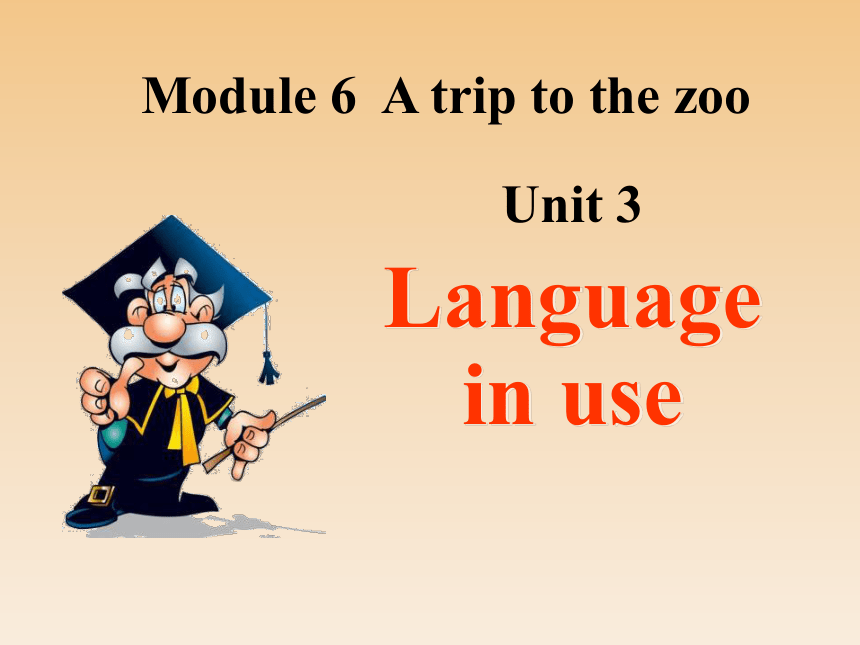 | |
| 格式 | zip | ||
| 文件大小 | 289.6KB | ||
| 资源类型 | 教案 | ||
| 版本资源 | 外研版 | ||
| 科目 | 英语 | ||
| 更新时间 | 2017-11-15 19:49:28 | ||
图片预览

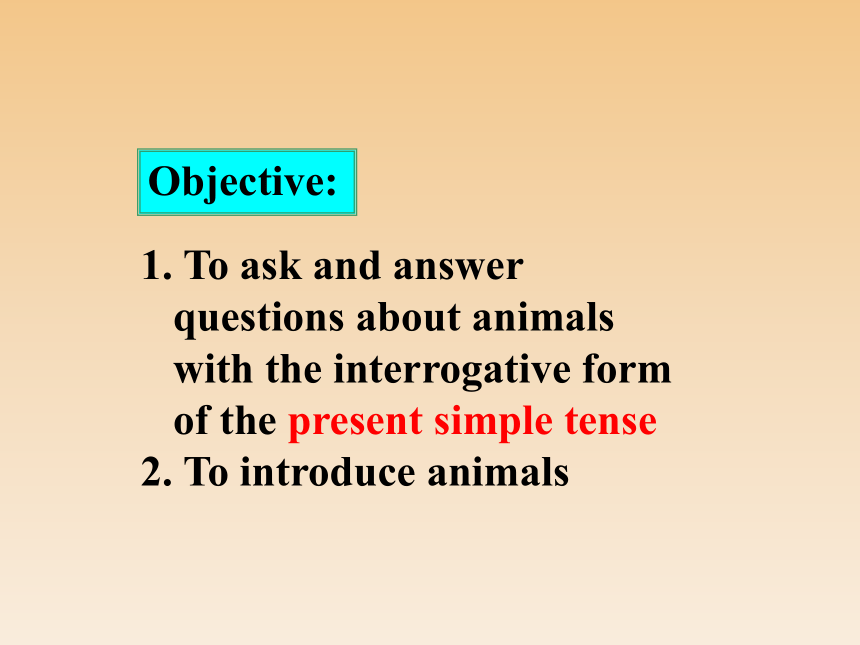

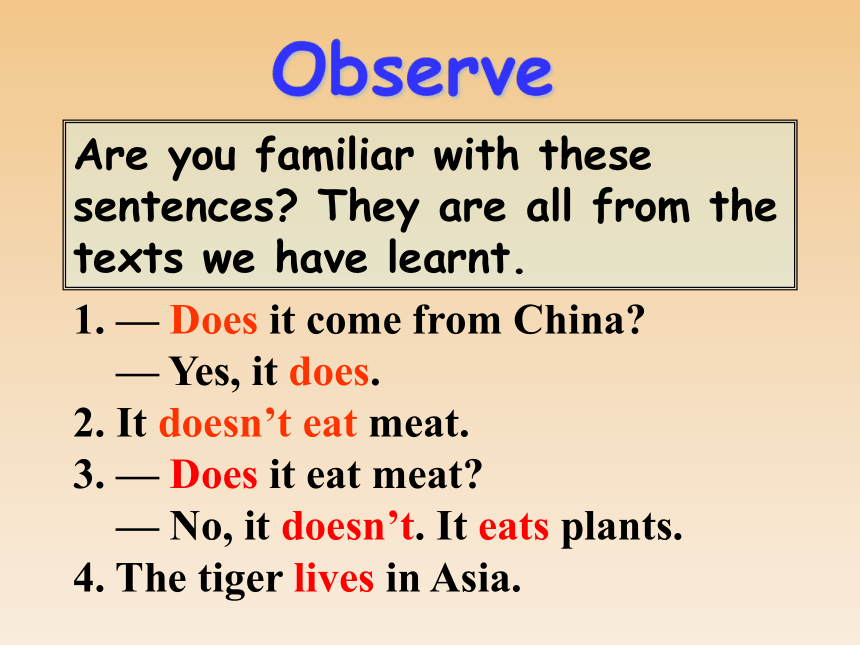

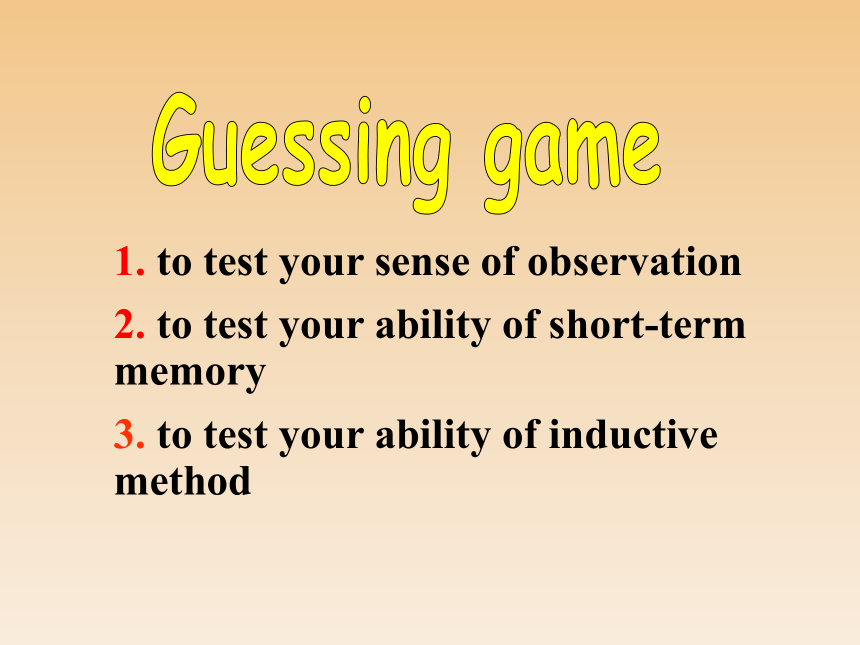
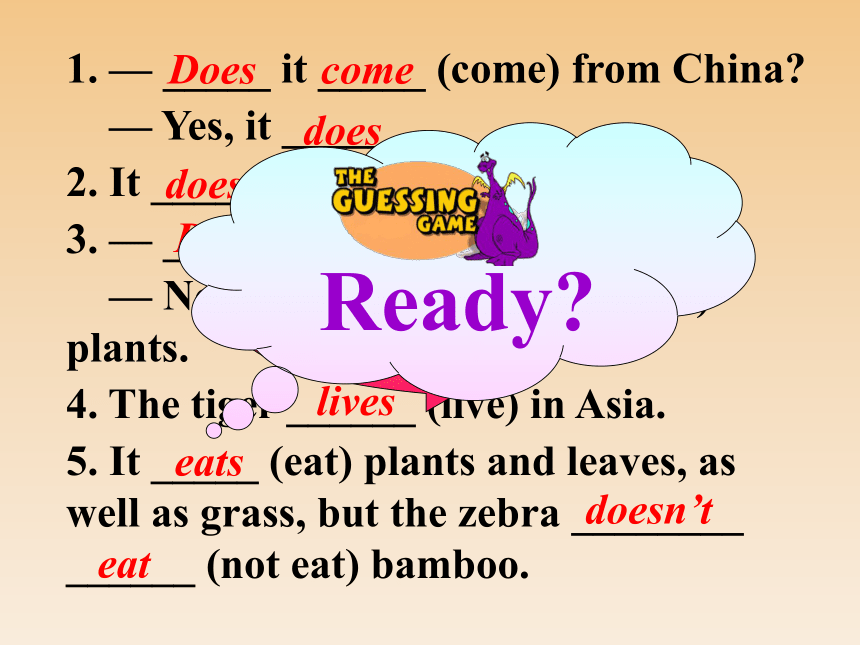
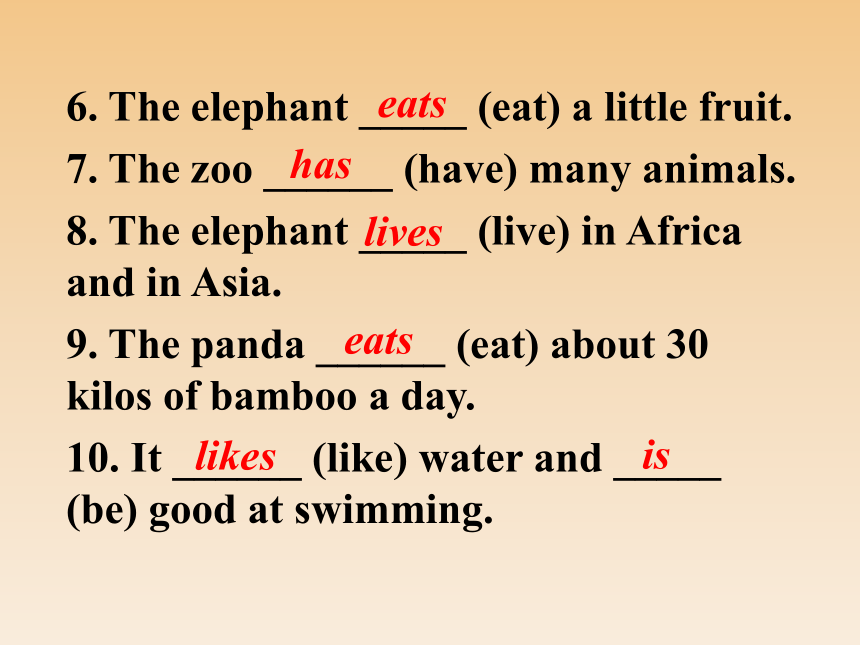

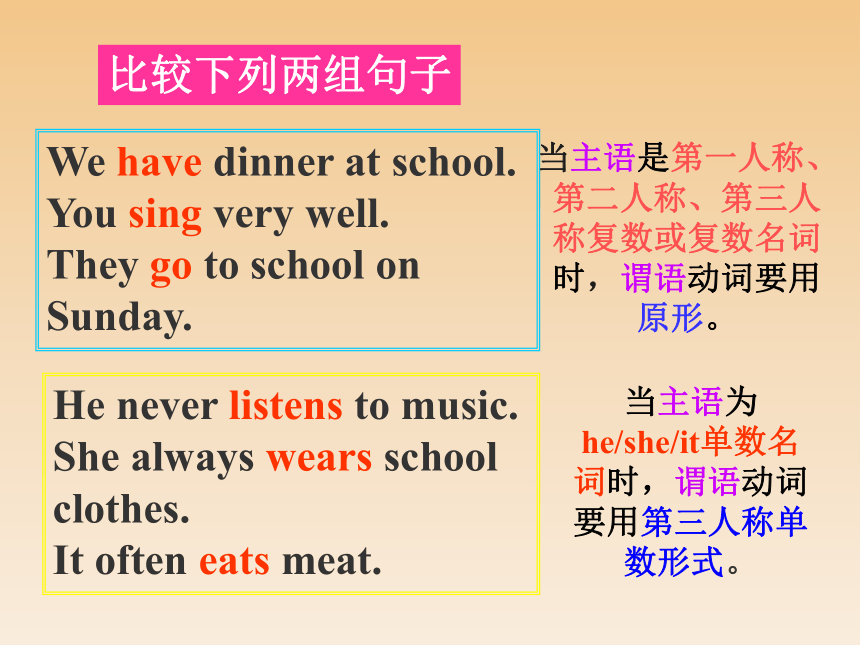
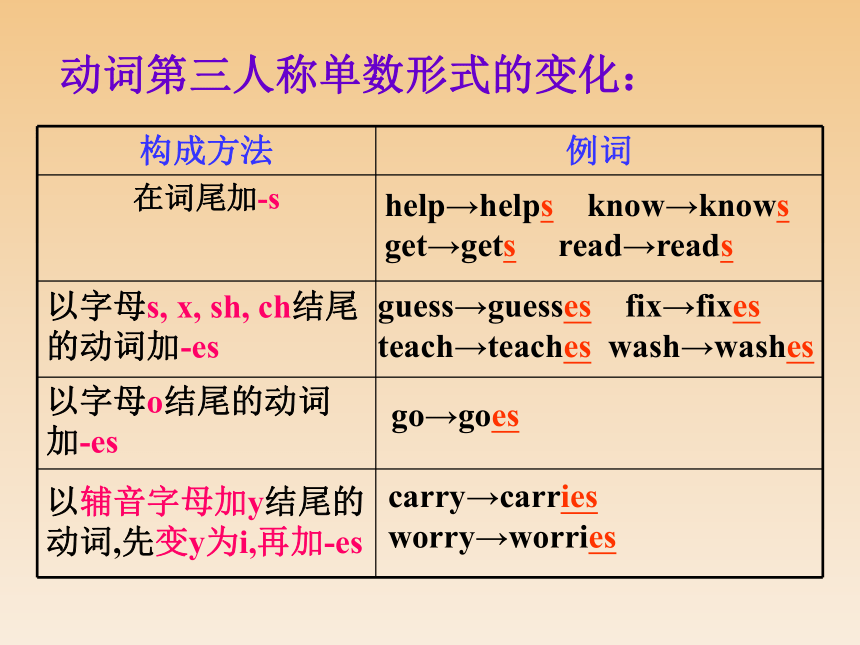
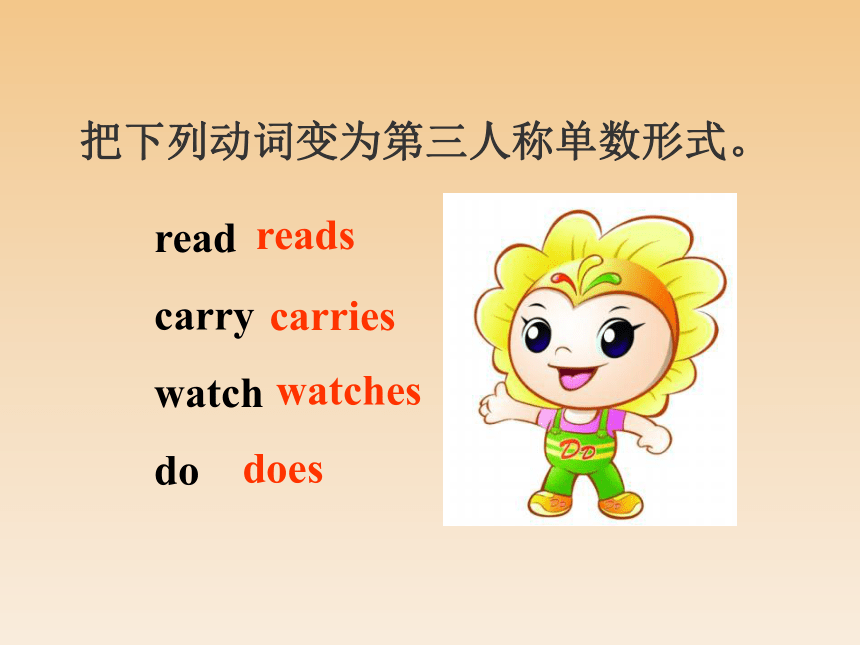
文档简介
课件32张PPT。Unit 3Language in useModule 6 A trip to the zooObjective:1. To ask and answer questions about animals with the interrogative form of the present simple tense
2. To introduce animals语法讲解建议采用归纳法,如尽可能多的呈现一些相关例句,或可让学生从已学课文中找相应例句,引导学生试着从所观察到的语言现象中总结出语法规律。1. — Does it come from China?
— Yes, it does.
2. It doesn’t eat meat.
3. — Does it eat meat?
— No, it doesn’t. It eats plants.
4. The tiger lives in Asia.ObserveAre you familiar with these sentences? They are all from the texts we have learnt.5. It eats plants and leaves, as well as grass, but the zebra doesn’t eat bamboo.
6. The elephant eats a little fruit.
7. The zoo has many animals.
8. The elephant lives in Africa and in Asia.
9. The panda eats about 30 kilos of bamboo a day.
10. It likes water and is good at swimming. Guessing game1. to test your sense of observation
2. to test your ability of short-term memory
3. to test your ability of inductive method1. — _____ it _____ (come) from China?
— Yes, it ______.
2. It _______ _____ (not eat) meat.
3. — _____ it _____ (eat) meat?
— No, it ________. It _____ (eat) plants.
4. The tiger ______ (live) in Asia.
5. It _____ (eat) plants and leaves, as well as grass, but the zebra ________ ______ (not eat) bamboo.Does comedoes doesn’t eatDoes eat doesn’teatsliveseats doesn’t eatgo
Ready?6. The elephant _____ (eat) a little fruit.
7. The zoo ______ (have) many animals.
8. The elephant _____ (live) in Africa and in Asia.
9. The panda ______ (eat) about 30 kilos of bamboo a day.
10. It ______ (like) water and _____ (be) good at swimming. eatshasliveseatslikesisGrammar行为动词的一般现在时(2)比较下列两组句子当主语是第一人称、第二人称、第三人称复数或复数名词时,谓语动词要用原形。We have dinner at school.
You sing very well.
They go to school on Sunday.当主语为he/she/it单数名词时,谓语动词要用第三人称单数形式。He never listens to music.
She always wears school clothes.
It often eats meat.动词第三人称单数形式的变化:help→helps know→knows
get→gets read→readsguess→guesses fix→fixes
teach→teaches wash→washesgo→goescarry→carries
worry→worries以字母s, x, sh, ch结尾的动词加-es以字母o结尾的动词加-es以辅音字母加y结尾的动词,先变y为i,再加-esPPT模板:www.1ppt.com/moban/ PPT素材:www.1ppt.com/sucai/
PPT背景:www.1ppt.com/beijing/ PPT图表:www.1ppt.com/tubiao/
PPT下载:www.1ppt.com/xiazai/ PPT教程: www.1ppt.com/powerpoint/
资料下载:www.1ppt.com/ziliao/ 范文下载:www.1ppt.com/fanwen/
试卷下载:www.1ppt.com/shiti/ 教案下载:www.1ppt.com/jiaoan/
PPT论坛:www.1ppt.cn PPT课件:www.1ppt.com/kejian/
语文课件:www.1ppt.com/kejian/yuwen/ 数学课件:www.1ppt.com/kejian/shuxue/
英语课件:www.1ppt.com/kejian/yingyu/ 美术课件:www.1ppt.com/kejian/meishu/
科学课件:www.1ppt.com/kejian/kexue/ 物理课件:www.1ppt.com/kejian/wuli/
化学课件:www.1ppt.com/kejian/huaxue/ 生物课件:www.1ppt.com/kejian/shengwu/
地理课件:www.1ppt.com/kejian/dili/ 历史课件:www.1ppt.com/kejian/lishi/ 把下列动词变为第三人称单数形式。read
carry
watch
doreadswatchescarriesdoes 她不说英语。
She doesn’t speak English.
他住地离学校不远。
He doesn’t live far away from school.如果表示不常做某事,该怎样表达呢?主语是第三人称单数的行为动词的一般
现在时否定形式是在行为动词前加
doesn’t (does not ),这时要注意把谓语动
词还原为动词原形。如果要问别人是否经常做某事,我们要采用下面的表达方式:
—Does the panda eat meat?
—No, it doesn’t.
—Does it eat bamboo?
—Yes, it does.
—Does he play the piano every day?
—No, he doesn’t.从以上例子可以看出,行为动词的第三
人称单数一般现在时疑问形式是在句首
加助动词does ,而加does之后,后面的
谓语动词像否定句一样也要用原形。
例如:
Does he get up very early?
他起床很早吗?
Does the panda come from China?
熊猫来自中国吗?总结行为动词一般现在时的各种句式变化:以下部分为课本练习,供老师在对答案时选择使用。Work in pairs. Look at the pictures. Ask and answer.Name: Meimei
From: Yunnan, China
Favourite food: fruit— Does Meimei the elephant come from Yunnan, China?
— Yes, it does.P401Name: Kingba
From: Asia
Favourite food: meatComplete the sentences with does or doesn’t.1. — ______ this panda come from China?
— Yes, it ______.
2. — _____ this panda eat fish?
— No, it _______.
3. — ______ this monkey like fruit?
— Yes, it ______.
4. — ______ this monkey live in Africa?
— No, it _______.
5. The zebra ______ like meat.P402Does does Does doesn’t Does does Does doesn’t doesn’t P403Complete the passage with the correct form of the words in brackets.My favourite animals (1) _____ (be) zebras. Look at this one. It (2) ______ (be) cute. It (3) _____ (be) black and white like the panda. But it (4) ______ (do not) come from Asia. It (5) ______ (come) from Africa. It (6) ______ (eat) grass.are is is doesn’t comes eats P414Complete the word map.The world
of animalsAsia America Europe monkeymonkeytigerpandamonkeyelephantgiraffeelephantzebraAfrica Module task:Making a poster of your favourite animalⅠ. Work in groups. Find out about an animal.?Talk about your favourite animal.
?Choose one animal to write about.
?Find out about the animal.Ⅱ. Make a poster about your group’s animal.Ⅲ. Present your poster to the class.?Draw it or find a photo.
?Write some information about it.肯定句:主语+动词的第三人称单数形式
否定句:主语+doesn’t +动词原形
疑问句:Does+主语+动词原形?
肯定回答:Yes, 主语+does.
否定回答:No, 主语+ doesn’t.现在把行为动词第三人称单数的各种
句式总结如下:ReviewⅠ. 用方框中所给单词或短语填空,每个单词或短语限用一次。1. This animal eats fruit, bread and _________ candies.funny, in fact, its, on the front of, eveneven2. The kangaroo has a pocket ____________ the body.
3. This is a very _________ book. You can read it.
4. I have a dog and _________ name is Dahua.
5. This animal isn’t from Asia. _________, it is from Africa.funny, in fact, its, on the front of, even on the front of funnyitsIn factⅡ. 用所给动词的正确形式完成下面的短文。
There is a big zoo in our city. There
(1) _________ (be) many different kinds of animals. There is a tiger (2) _______ (call) Liangliang. It (3) _________ (come) from Asia. It usually (4) _________ (eat) some small animals for food. It (5) _________ (not eat) grass or leaves.arecalledcomeseats doesn’t eatⅢ. 根据情景,选用适当的句子补全对
话。A. How many pandas are
there in the zoo?
B. It is next to my home.
C. Do pandas like hot weather?
D. What is your favourite animal?
E. They are different.A: Good morning, Xu Fei.
B: Good morning, Wen Li.
A: Do you know Changsha Ecological Zoo
(长沙生态动物园)?
B: Yes, I do. (1) _________
A: Oh, that’s wonderful.
B: (2) _________
A: Pandas. (3) _________
B: There are four now. Erxi and Yayun are two
new pandas.
A: What are they like?
B: (4) _________ Erxi is very lively (活泼的), but
Yayun is very quiet (安静的).
A: That is too interesting. Changsha is very hot. (5)
_______
B: No, they like cool weather.BDAEC1. Finish the exercises in Learning English.
2. Preview the new words and
expressions in Module 7.
3. Search for information about the history of computer. Homework
2. To introduce animals语法讲解建议采用归纳法,如尽可能多的呈现一些相关例句,或可让学生从已学课文中找相应例句,引导学生试着从所观察到的语言现象中总结出语法规律。1. — Does it come from China?
— Yes, it does.
2. It doesn’t eat meat.
3. — Does it eat meat?
— No, it doesn’t. It eats plants.
4. The tiger lives in Asia.ObserveAre you familiar with these sentences? They are all from the texts we have learnt.5. It eats plants and leaves, as well as grass, but the zebra doesn’t eat bamboo.
6. The elephant eats a little fruit.
7. The zoo has many animals.
8. The elephant lives in Africa and in Asia.
9. The panda eats about 30 kilos of bamboo a day.
10. It likes water and is good at swimming. Guessing game1. to test your sense of observation
2. to test your ability of short-term memory
3. to test your ability of inductive method1. — _____ it _____ (come) from China?
— Yes, it ______.
2. It _______ _____ (not eat) meat.
3. — _____ it _____ (eat) meat?
— No, it ________. It _____ (eat) plants.
4. The tiger ______ (live) in Asia.
5. It _____ (eat) plants and leaves, as well as grass, but the zebra ________ ______ (not eat) bamboo.Does comedoes doesn’t eatDoes eat doesn’teatsliveseats doesn’t eatgo
Ready?6. The elephant _____ (eat) a little fruit.
7. The zoo ______ (have) many animals.
8. The elephant _____ (live) in Africa and in Asia.
9. The panda ______ (eat) about 30 kilos of bamboo a day.
10. It ______ (like) water and _____ (be) good at swimming. eatshasliveseatslikesisGrammar行为动词的一般现在时(2)比较下列两组句子当主语是第一人称、第二人称、第三人称复数或复数名词时,谓语动词要用原形。We have dinner at school.
You sing very well.
They go to school on Sunday.当主语为he/she/it单数名词时,谓语动词要用第三人称单数形式。He never listens to music.
She always wears school clothes.
It often eats meat.动词第三人称单数形式的变化:help→helps know→knows
get→gets read→readsguess→guesses fix→fixes
teach→teaches wash→washesgo→goescarry→carries
worry→worries以字母s, x, sh, ch结尾的动词加-es以字母o结尾的动词加-es以辅音字母加y结尾的动词,先变y为i,再加-esPPT模板:www.1ppt.com/moban/ PPT素材:www.1ppt.com/sucai/
PPT背景:www.1ppt.com/beijing/ PPT图表:www.1ppt.com/tubiao/
PPT下载:www.1ppt.com/xiazai/ PPT教程: www.1ppt.com/powerpoint/
资料下载:www.1ppt.com/ziliao/ 范文下载:www.1ppt.com/fanwen/
试卷下载:www.1ppt.com/shiti/ 教案下载:www.1ppt.com/jiaoan/
PPT论坛:www.1ppt.cn PPT课件:www.1ppt.com/kejian/
语文课件:www.1ppt.com/kejian/yuwen/ 数学课件:www.1ppt.com/kejian/shuxue/
英语课件:www.1ppt.com/kejian/yingyu/ 美术课件:www.1ppt.com/kejian/meishu/
科学课件:www.1ppt.com/kejian/kexue/ 物理课件:www.1ppt.com/kejian/wuli/
化学课件:www.1ppt.com/kejian/huaxue/ 生物课件:www.1ppt.com/kejian/shengwu/
地理课件:www.1ppt.com/kejian/dili/ 历史课件:www.1ppt.com/kejian/lishi/ 把下列动词变为第三人称单数形式。read
carry
watch
doreadswatchescarriesdoes 她不说英语。
She doesn’t speak English.
他住地离学校不远。
He doesn’t live far away from school.如果表示不常做某事,该怎样表达呢?主语是第三人称单数的行为动词的一般
现在时否定形式是在行为动词前加
doesn’t (does not ),这时要注意把谓语动
词还原为动词原形。如果要问别人是否经常做某事,我们要采用下面的表达方式:
—Does the panda eat meat?
—No, it doesn’t.
—Does it eat bamboo?
—Yes, it does.
—Does he play the piano every day?
—No, he doesn’t.从以上例子可以看出,行为动词的第三
人称单数一般现在时疑问形式是在句首
加助动词does ,而加does之后,后面的
谓语动词像否定句一样也要用原形。
例如:
Does he get up very early?
他起床很早吗?
Does the panda come from China?
熊猫来自中国吗?总结行为动词一般现在时的各种句式变化:以下部分为课本练习,供老师在对答案时选择使用。Work in pairs. Look at the pictures. Ask and answer.Name: Meimei
From: Yunnan, China
Favourite food: fruit— Does Meimei the elephant come from Yunnan, China?
— Yes, it does.P401Name: Kingba
From: Asia
Favourite food: meatComplete the sentences with does or doesn’t.1. — ______ this panda come from China?
— Yes, it ______.
2. — _____ this panda eat fish?
— No, it _______.
3. — ______ this monkey like fruit?
— Yes, it ______.
4. — ______ this monkey live in Africa?
— No, it _______.
5. The zebra ______ like meat.P402Does does Does doesn’t Does does Does doesn’t doesn’t P403Complete the passage with the correct form of the words in brackets.My favourite animals (1) _____ (be) zebras. Look at this one. It (2) ______ (be) cute. It (3) _____ (be) black and white like the panda. But it (4) ______ (do not) come from Asia. It (5) ______ (come) from Africa. It (6) ______ (eat) grass.are is is doesn’t comes eats P414Complete the word map.The world
of animalsAsia America Europe monkeymonkeytigerpandamonkeyelephantgiraffeelephantzebraAfrica Module task:Making a poster of your favourite animalⅠ. Work in groups. Find out about an animal.?Talk about your favourite animal.
?Choose one animal to write about.
?Find out about the animal.Ⅱ. Make a poster about your group’s animal.Ⅲ. Present your poster to the class.?Draw it or find a photo.
?Write some information about it.肯定句:主语+动词的第三人称单数形式
否定句:主语+doesn’t +动词原形
疑问句:Does+主语+动词原形?
肯定回答:Yes, 主语+does.
否定回答:No, 主语+ doesn’t.现在把行为动词第三人称单数的各种
句式总结如下:ReviewⅠ. 用方框中所给单词或短语填空,每个单词或短语限用一次。1. This animal eats fruit, bread and _________ candies.funny, in fact, its, on the front of, eveneven2. The kangaroo has a pocket ____________ the body.
3. This is a very _________ book. You can read it.
4. I have a dog and _________ name is Dahua.
5. This animal isn’t from Asia. _________, it is from Africa.funny, in fact, its, on the front of, even on the front of funnyitsIn factⅡ. 用所给动词的正确形式完成下面的短文。
There is a big zoo in our city. There
(1) _________ (be) many different kinds of animals. There is a tiger (2) _______ (call) Liangliang. It (3) _________ (come) from Asia. It usually (4) _________ (eat) some small animals for food. It (5) _________ (not eat) grass or leaves.arecalledcomeseats doesn’t eatⅢ. 根据情景,选用适当的句子补全对
话。A. How many pandas are
there in the zoo?
B. It is next to my home.
C. Do pandas like hot weather?
D. What is your favourite animal?
E. They are different.A: Good morning, Xu Fei.
B: Good morning, Wen Li.
A: Do you know Changsha Ecological Zoo
(长沙生态动物园)?
B: Yes, I do. (1) _________
A: Oh, that’s wonderful.
B: (2) _________
A: Pandas. (3) _________
B: There are four now. Erxi and Yayun are two
new pandas.
A: What are they like?
B: (4) _________ Erxi is very lively (活泼的), but
Yayun is very quiet (安静的).
A: That is too interesting. Changsha is very hot. (5)
_______
B: No, they like cool weather.BDAEC1. Finish the exercises in Learning English.
2. Preview the new words and
expressions in Module 7.
3. Search for information about the history of computer. Homework
同课章节目录
- Starte
- Module 1 My teacher and my friends
- Module 2 My English lesson
- Module 3 My English book
- Module 4 My everyday life
- Module 1 My classmates
- Unit 1 Nice to meet you.
- Unit 2 I'm Wang Lingling and I'm thirteen years ol
- Unit 3 Language in use.
- Module 2 My family
- Unit 1 Is this your mum?
- Unit 2 These are my parents.
- Unit 3 Language in use.
- Module 3 My school
- Unit 1 There are thirty students in my class.
- Unit 2 The library is on the left of the playgroun
- Unit 3 Language in use.
- Module 4 Healthy food
- Unit 1 We've got lots of apples.
- Unit 2 Is your food and drink healthy?
- Unit 3 Language in use.
- Module 5 My school day
- Unit 1 I love history.
- Unit 2 We start work at nine o'clock.
- Unit 3 Language in use.
- Revision module A
- Module 6 A trip to the zoo
- Unit 1 Does it eat meat?
- Unit 2 The tiger lives in Asia.
- Unit 3 Language in use.
- Module 7 Computers
- Unit 1 How do I write my homework on the computer?
- Unit 2 When do you use a computer?
- Unit 3 Language in use.
- Module 8 Choosing presents
- Unit 1 I always like birthday parties.
- Unit 2 She often goes to concerts.
- Unit 3 Language in use.
- Module 9 People and places
- Unit 1 We're enjoying the school trip a lot.
- Unit 2 They're waiting for buses or trains.
- Unit 3 Language in use.
- Module 10 Spring Festival
- Unit 1 Are you getting ready for Spring Festival?
- Unit 2 My mother's cleaning our houses and sweepin
- Unit 3 Language in use.
- Revision module B
